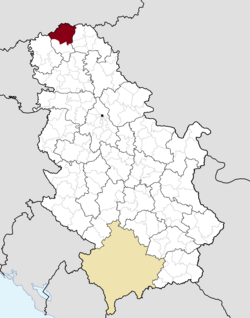Subotica
|
Subotica Град Суботица Szabadka |
|||||||
|---|---|---|---|---|---|---|---|
| City | |||||||
| City of Subotica | |||||||
Subotica photomontage
|
|||||||
|
|||||||
 Location of the city of Subotica within Serbia |
|||||||
| Coordinates: 46°06′01″N 19°39′56″E / 46.10028°N 19.66556°ECoordinates: 46°06′01″N 19°39′56″E / 46.10028°N 19.66556°E | |||||||
| Country |
|
||||||
| Province | Vojvodina | ||||||
| District | North Bačka | ||||||
| Settlements | 19 | ||||||
| Government | |||||||
| • Mayor | Bogdan Laban (SNS) | ||||||
| • Ruling parties | SNS/SVM | ||||||
| Area | |||||||
| • Land | 1,008 km2 (389 sq mi) | ||||||
| Elevation | 109 m (358 ft) | ||||||
| Population (2011) | |||||||
| • City | 97,910 | ||||||
| • Rank | 5th | ||||||
| • Urban | 105,681 | ||||||
| • Metro | 141,554 | ||||||
| Time zone | CET (UTC+1) | ||||||
| • Summer (DST) | CEST (UTC+2) | ||||||
| Postal code | 24000 | ||||||
| Area code(s) | (+381) 24 | ||||||
| Vehicle registration | SU | ||||||
| Website | Official website | ||||||
Subotica (Serbian Cyrillic: Суботица [sǔbɔtit͡sa], Hungarian: Szabadka) is a city and the administrative center of the North Bačka District in the autonomous province of Vojvodina, Serbia. Formerly the largest city of Vojvodina region, contemporary Subotica is now the second largest city in the province, following the city of Novi Sad. According to the 2011 census, the city itself has a population of 97,910, while the urban area of Subotica (with adjacent urban settlement of Palić included) has 105,681 inhabitants, and the population of metro area (the administrative area of the city) stands at 141,554 people.
The earliest known written name of the city was Zabotka or Zabatka, which dates from 1391. It is the origin of the current Hungarian name for the city "Szabadka".
According to one opinion, the Name "Szabadka" comes from the adjective szabad, which derived from the Slavic word for "free" – svobod. According to this view, Subotica's earliest designation would mean, therefore, something like a "free place".
The origin of the earliest form of the name (Zabotka or Zabatka) is obscure. However, according to a local Bunjevci newspaper, Zabatka could have derived from the South Slavic word "zabat" (Gable), which describe parts of Pannonian Slavic houses.
The town was named in the 1740s for Maria Theresa of Austria, Archduchess of Austria. It was officially called Sent-Maria in 1743, but was renamed in 1779 as Maria-Theresiapolis. These two official names were also spelled in several different ways (most commonly the German Maria-Theresiopel or Theresiopel), and were used in different languages.
...
Wikipedia







